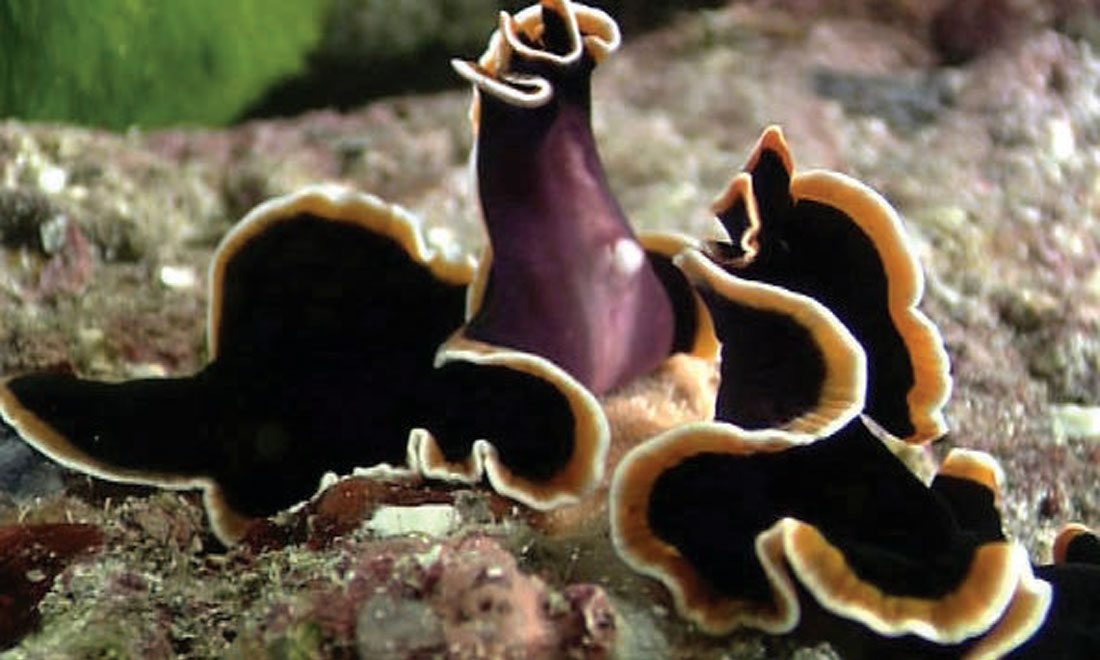My apologies, I’ve run out of time to complete my planned article on electrical methods. Rather than miss an entire month of Science Break, I offer you a string of random information with a tenuous connection to science. This basically buys me another month to get my electrical methods done.
Given the Christmas season was upon us as I wrote this, it seemed appropriate to ponder the many unique ways that species reproduce. It reminds me of a story I heard about my grandmother (don’t worry, as far as I know her sexual habits were entirely normal). She was a U of T professor of English starting in 1920 and Dean of Women at one of its colleges for many years, when it was unusual for women to hold such positions. She was able to achieve back then what is now considered normal for women – combine a career and raise a family. A baffled Toronto matron once asked her, “Mrs. Kirkwood, how on earth have you had children?” to which she replied, “The normal way.” Well, in the animal kingdom I can assure you that many species reproduce in ways that we would definitely not consider normal.

Let’s start with a small jellyfish called Turritopsis dohrnii which doesn’t die unless killed by a predator (Wikimedia Foundation, Inc., 2013a). If it gets sick or wounded and is in danger of dying, its cells can revert back to the polyp stage, effectively starting life over. There is no limit to the number of times this can happen, giving rise to its nickname, the “immortal jellyfish”.
The animal kingdom is full of bizarre (and when I say bizarre I really mean it) mating rituals and reproduction mechanisms. Flatworms from the Phylum Platyhelminthes, a type of sea floor slug, are an example of almost perfect sexual equality, and one that will leave human readers appreciative of our own asymmetry in these matters (Wikimedia Foundation, Inc., 2013b). All flatworms are hermaphrodites, and when a pair decides to mate, first they struggle to determine who goes on top, and then the penis fencing starts; the first one to successfully stab the other one becomes Daddy, and the other Mommy. (Search on “flatworm penis fencing” to see clips!)

Speaking of penises, that of the Echidna or spiny anteater is worth mentioning (Wikimedia Foundation, Inc., 2013c). Not only are they 7 cm long, impressive for quite a small animal, but they also possess spines along the shaft and 4 heads. Nothing like carrying around a fancy shower attachment between your legs. The design features of the receiving half of the system I will leave to your imagination. Echidnae belong to the small group of egg laying mammals known as monotremes. Like platypuses, echidnae have electroreceptors in their snouts which help them locate ants in the earth or rotten logs. (There you go, I did mention at least one electrical exploration method!)

Several species change sex on an as needed basis. Clownfish live in groups with only one mating pair. If the mating female dies, then one of the larger males turns into a female, and it’s game on again. Many types of frogs have the ability to change sex, and this happens in order to maintain the correct male to female ratio within a local population. Imagine if humans could do that – we’d have all those precious boys in China turning into girls, and lonely Russian women transforming into vodka swilling louts.
The male anglerfish is tiny, and physically latches on to the female and lives as a parasite until she’s ready to be fertilized. Reminds me of someone I used to know. Male cichlid fish ejaculate in the general vicinity of the female; the female has previously “placed” her unfertilised eggs in her mouth, so she gulps in the sperm, and the fertilised eggs then incubate and hatch in her mouth. When it comes to the real romantics, we’ve got the male hippo who sprays the female with his feces to get her in the mood, and the male giraffe who showers the female with his urine to similar effect. The most incredibly bizarre, beyond belief almost, reproduction strategies I’ve come across are those of various parasitoids, but I’ve written about them before, back in my very first SB article (Kuhn, Parasitoids, 2008). So maybe the concept of immaculate conception isn’t that far out there after all...
Let’s segue from weird sex to Paracelsus, who conducted an experiment to artificially create a small, perfect human male known as a homunculus (Wikimedia Foundation, Inc., 2013d); apparently back in the middle ages this was a popular goal, perhaps a diversion for alchemists who got tired of trying to create gold. Paracelsus bottled some sperm, stuck the bottle in horse manure for 20 days, and once hatched was planning to feed “him” blood for 40 days to bring him to maturity. Note that a big motivator here was to create a male who was unsullied by all those nasty juices found inside females. Nowadays the shoe is on the other foot – the last few months have seen a barrage of opinions expressed by female intellectuals on the superfluousness of males, and how to get on with running the world better without them.
Perhaps proof that the male half of the species really isn’t that useful, and can take active steps to remove themselves from the gene pool without any encouragement from female intellectuals, we have scientists Hebert Woollard and Edward Carmichael who, in order to study the phenomenon of referred pain (pain perceived to be at a location other than where its source is), devised the following ingenious experiment (alex, 2011). One of them laid down on the table, while the other stacked increasing numbers of bricks on the other’s testicles. They then documented the nature and location of the pain as the weight increased. Their observations and conclusions have never been reproduced due to a lack of interest in doing so.

In a similar vein, Giovanni Grassi (Wikimedia Foundation, Inc., 2013e) is credited with proving that roundworms are transmitted via fecal matter. He took it upon himself to ingest fecal roundworm eggs from a corpse, but only after carefully examining his own feces to be sure he didn’t already have roundworms. He then spent the next weeks or months carefully examining his feces for signs of roundworm eggs. Ah, the noble scientist, societal paragon...
Allan Blair expanded our understanding of the effects of the Black Widow spider bite, by willingly allowing a very angry female to inject her venom into him for a full 10 seconds. The awful and extensive effects on his various body systems were carefully recorded for the 3 long days they lasted.

I guess I don’t feel much sympathy for these nitwits and their self-imposed experiments, but I do have a problem with scientists who conduct horrific experiments on helpless animals. For example, take Warren Thomas who injected an elephant at an Oklahoma City zoo in 1962 with almost 300 mg of LSD to see if it would provoke “musth”, a state of heightened sexual aggression in male bull elephants. After an hour and forty minutes of suffering the elephant died (Anonymous blogger, 2012). I can’t even bring myself to read about the various “experiments” conducted in the name of science on unwilling and unknowing humans in the same manner. For example, in the 1950’s a CIA psychiatrist (Wikimedia Foundation, Inc., 2013f) conducted horrifying experiments on innocent hospital patients, many under treatment for minor mental conditions such as post-partum depression or various anxiety disorders. This work was done with apparent tacit Canadian government approval, and often resulted in permanent damage to the “subjects” (Wikimedia Foundation, Inc., 2013g).
But if you’ve read this far it’s probably because at heart, you find science fun. To usher in the New Year, I’ll finish off with a few really interesting and entertaining scientific discoveries of 2013. All I had to do was search on “science discoveries 2013”, and bingo, a Wikipedia page on that very topic popped up (Wikimedia Foundation, Inc., 2013h). As a Wikipedia addict, I urge anyone who makes use of the site to donate an appropriate amount to the foundation; I truly believe it is one of humanity’s greatest achievements – a vast, collectively created and monitored trove of knowledge, available to any and all, for free.
In 2013 scientists were able to grow teeth, ears, livers and blood cells in a laboratory. Physicists successfully developed a method to achieve negative thermodynamic temperatures on the Kelvin or Rankine scales; for the life of me, I have no idea what that actually means, and reading about it further on Wikipedia got me even more confused. Archaeologists found zinc pills in a Roman ship wreck, providing evidence that their medical techniques were probably more sophisticated than previously thought; anything pulled out of classical Greek and Roman shipwrecks ranks high on my interest scale, even if it’s not evidence of anything. A German arms manufacturer unveiled a military laser capable of destroying drones and piercing steel from a mile away, even in poor weather conditions. The entire Neanderthal genome was sequenced. It was found that boron nitride could be very effective at cleaning up oil spills. The life spans of fruit were extended by ~25% by boosting a single gene. I’m just skimming the surface – check the page out yourself. There is obviously no shortage of topics for future Science Break articles; the challenge will be to find the time!
Happy New Year everyone.
References
alex. (2011, August 1). The Doctor Who Stacked Weights on His Testicles. Retrieved December 12, 2013, from Mad Science Museum: http://www.madsciencemuseum.com/msm/pl/sensitive_testes
Anonymous blogger. (2012, February 18). Tusko’s Trip. Retrieved December 12, 2013, from The Glyptodon: http://theglyptodon.wordpress.com/2012/02/18/tuskos-trip/
Kuhn, O. (2008, March). Parasitoids. CSEG RECORDER, 33(3), pp. 56-57.
Wikimedia Foundation, Inc. (2013h, December 12). 2013 in science. Retrieved December 12, 2013, from Wikipedia: http://en.wikipedia.org/wiki/2013_in_science
Wikimedia Foundation, Inc. (2013f, December 4). Donald Ewen Cameron. Retrieved December 12, 2013, from Wikipedia: http://en.wikipedia.org/wiki/Donald_Ewen_Cameron
Wikimedia Foundation, Inc. (2013c, December 9). Echidna. Retrieved December 12, 2013, from Wikipedia: http://en.wikipedia.org/wiki/Echidna
Wikimedia Foundation, Inc. (2013b, December 10). Flatworm. Retrieved December 13, 2013, from Wikipedia: http://en.wikipedia.org/wiki/Flatworm
Wikimedia Foundation, Inc. (2013e, November 24). Giovanni Battista Grassi. Retrieved December 12, 2013, from Wikipedia: http://en.wikipedia.org/wiki/Giovanni_Battista_Grassi
Wikimedia Foundation, Inc. (2013d, November 27). Homunculus. Retrieved December 12, 2013, from Wikipedia: http://en.wikipedia.org/wiki/Homunculus
Wikimedia Foundation, Inc. (2013g, December 10). Project MKUltra. Retrieved December 12, 2013, from Wikipedia: http://en.wikipedia.org/wiki/Project_MKUltra
Wikimedia Foundation, Inc. (2013a, November 26). Turritopsis dohrnii. Retrieved December 12, 2013, from Wikipedia: http://en.wikipedia.org/wiki/Turritopsis_dohrnii











Share This Column